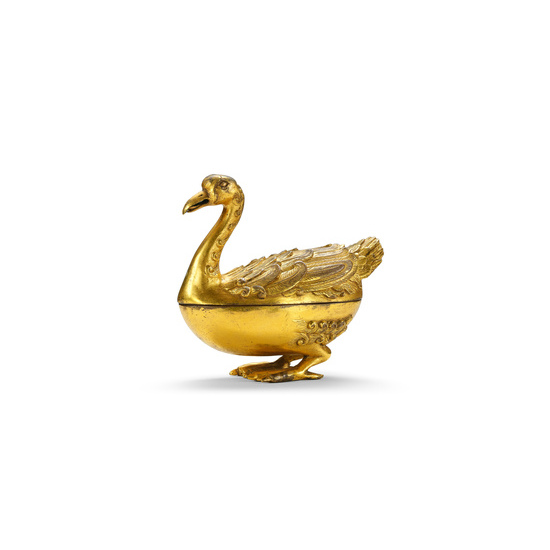CATALOGUE 2024
MING DYNASTY, 15TH CENTURY
HEIGHT: 9.3CM
WEIGHT: 387.5G
The censer is intricately cast and skilfully modelled as a duck, with the upper body
forming the cover and its belly and webbed feet as the base. The bird is depicted
with a curved S-shaped neck elegantly rising to a small head surmounted by
a knop and detailed with almond-shaped eyes and a pointed bill. Its back, tail
and neck are finely detailed with overlapping layers of curled plumage. The
underside of the cover is cast with two openings where incense smoke can emit
through the bird’s agape mouth and another vent hole near its tail.
SIMILAR EXAMPLES
Censers in the form of water birds were known as early as the Han dynasty;
the present example appears to follow a long tradition of such depictions
characteristic of the Song and Ming dynasty revivals. A larger goose dated to the
Song-Ming dynasty, with closely related representation of the laid plumage and
similarly coiled feathers along the bird’s neck, was sold at Christie’s New York,
29th March 2006, lot 320.
Duck-form censers were particularly popular during the Ming dynasty. Gilt
bronze examples like the present piece were reputedly used in imperial banquets
in the early 15th century, as recorded in ancient poetic texts by the Ming scholars
Zhu Youdun 朱有燉 (1379-1439) and Jin Shan 金善 (1368-1431), despite the
absence of imperial reign marks on these examples. Such censers were also
known in ceramic form, see a sancai example excavated from the Chenghua
stratum at the Ming imperial kiln site at Zhushan, Jingdezhen, illustrated in
Imperial Porcelain: Recent Discoveries of Jingdezhen Ware, Museum of Oriental
Ceramics, Osaka, 1995, Catalogue No. 116; and ungilt bronze such as one from
the Tokugawa Art Museum, Nagoya, included in the Shogun Age Exhibition:
From the Tokugawa Art Museum, Japan, Tokyo, 1983, p. 107, no. 75; and
another slightly backward-leaning goose on a pedestal from the British Museum,
London, illustrated in Catalogue of Late Yuan and Ming Ceramics in the British
Museum, 2001, London, Catalogue No. 16:92 (Fig. 1).
| 明十五世紀 銅鎏金寶鴨香薰 |
